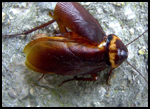
 |
|
HOME
CONTACT US
SERVICES
|
HabitsGerman cockroaches usually prefer a moist environment with a relatively high degree of warmth. HabitatThe insects are mostly scavengers and will feed on a wide variety of foods. They are especially fond of starches, sweets, grease, and meat products. In many locations, garbage is a principal food source. As with other species, German cockroaches are mostly active at night, when they forage for food, water, and mates. During the day they hide in cracks and crevices and other dark sites that provide a warm and humid environment. Their relatively wide, flat bodies enable them to move in and out of cracks and narrow openings with ease. They may be seen during the daytime, particularly if a heavy population is present or if there is some other stress, such as a lack of food or water or an application of pesticides. ThreatsGerman cockroaches produce odorous secretions that can affect the flavor of various foods. When cockroach populations are high, these secretions may result in a characteristic odor in the general region of the infestation. Disease-producing organisms such as bacteria, protozoans, and viruses have been found on cockroach bodies. Different forms of gastroenteritis (food poisoning, dysentery, diarrhea, and other illnesses) appear to be the principal diseases transmitted by German cockroaches. The organisms causing these diseases are carried on the legs and bodies of cockroaches and are deposited on food and utensils as the cockroaches forage. Cockroach excrement and cast skins also contain a number of allergens to which many people exhibit allergic responses, such as skin rashes, watery eyes and sneezing, congestion of nasal passages, and asthma.
Prevention:A key factor in prevention is sanitation. Clean up all spilled foods, including crumbs on the floor. Do not leave dirty dishes overnight. Store items such as cereal, crackers, cookies, flour, sugar, and bread in airtight sealed containers. Empty garbage each evening into a sturdy container with a tightly fitted lid. Structural modifications such as caulking holes in walls where pipes pass through are necessary in the kitchen, bathroom, and other areas of the house in order to control German cockroaches. Oriental Cockroaches |
| Color: | Dark brown to black in colour and has a glossy body |
| Legs: | 6 |
| Shape: | Oval |
| Size: | 25 mm (2.5 cm) to 30 mm (3.0 cm) |
| Antennae: | True |
| Region: | Found around the world |
Also known as "waterbugs" or "black beetles"
They prefer warm places and a relatively high humidity if possible; they also need a source of food/liquid. The optimum temperature for oriental cockroaches is between 20 °C (68 °F) to 29 °C (84 °F)
They are often called "waterbugs" since they prefer dark, moist places. They can often be found around decaying organic matter, and in sewers, drains, damp basements, porches, and other damp locations. They can be found outside in bushes, under leaf groundcover, under mulch, and around other damp places outdoors.
The most important aspect of cockroach damage derives from their habit of feeding and harboring in damp and unsanitary places such as sewers, garbage disposals, kitchens, bathrooms, and indoor storage areas. Filth from these sources is spread by cockroaches to food supplies, food preparation surfaces, dishes, utensils, and other surfaces. Cockroaches contaminate far more food than they are able to eat.
Caulk all penetrations through ground level walls, stop water leaks, screen equipment overflow drains, and take overflow water away from buildings, keep drain traps full or capped. Remove rotting leaves from window wells. Move garbage cans out of preferred moist habitat. Ventilate moist space.

| Color: | Tan to light brown. It has two light-colored bands across the wings and abdomen |
| Legs: | 6 |
| Shape: | Oval |
| Size: | 10 to 14 mm long |
| Antennae: | True |
| Region: | Found throughout the US |
Nocturnal; can fly. They may be found throughout any structure, but prefer dry, warm areas, high locations and inside furniture.
They need less moisture than the German Cockroach so they tend to be more broadly distributed in the home, such as in living rooms and bedrooms. They can often be found in homes and apartments, but are less common in restaurants. They tend not to be found in the daytime, since they avoid light.
The brownbanded cockroach feeds on a wide variety of materials. Like members of other cockroach species, it may consume materials like glue or paste (especially from animal-based materials), starch, and certain color dyes. As a result, items like stamps, envelopes, bindings of older books, draperies, and occasionally wallpapers may show signs of feeding. This species has also been known to chew on nonfood materials, such as nylon stockings, presumably for the residues of body oils and skin flakes.
Brown-banded cockroaches can conceal themselves in many places that are inaccessible to larger species. Making structural modifications such as caulking (in cracks, crevices; around ducts, molding, etc.) is necessary in bedrooms, bathrooms, dining rooms, and other areas of the house.
